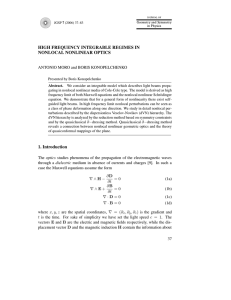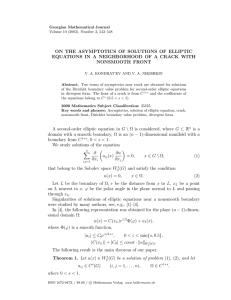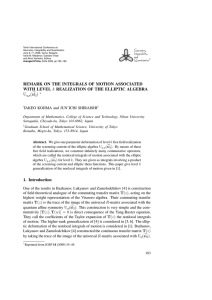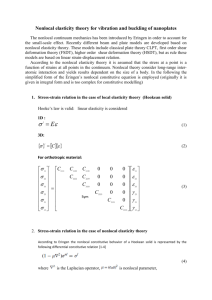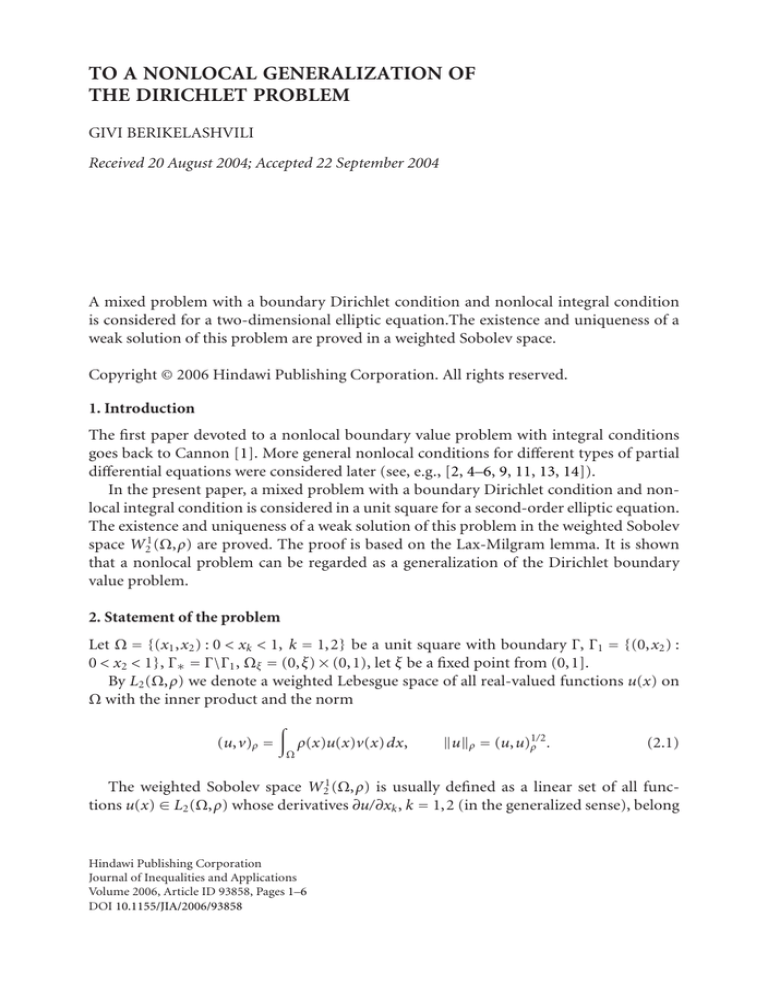
TO A NONLOCAL GENERALIZATION OF
THE DIRICHLET PROBLEM
GIVI BERIKELASHVILI
Received 20 August 2004; Accepted 22 September 2004
A mixed problem with a boundary Dirichlet condition and nonlocal integral condition
is considered for a two-dimensional elliptic equation.The existence and uniqueness of a
weak solution of this problem are proved in a weighted Sobolev space.
Copyright © 2006 Hindawi Publishing Corporation. All rights reserved.
1. Introduction
The first paper devoted to a nonlocal boundary value problem with integral conditions
goes back to Cannon [1]. More general nonlocal conditions for different types of partial
differential equations were considered later (see, e.g., [2, 4–6, 9, 11, 13, 14]).
In the present paper, a mixed problem with a boundary Dirichlet condition and nonlocal integral condition is considered in a unit square for a second-order elliptic equation.
The existence and uniqueness of a weak solution of this problem in the weighted Sobolev
space W21 (Ω,ρ) are proved. The proof is based on the Lax-Milgram lemma. It is shown
that a nonlocal problem can be regarded as a generalization of the Dirichlet boundary
value problem.
2. Statement of the problem
Let Ω = {(x1 ,x2 ) : 0 < xk < 1, k = 1,2} be a unit square with boundary Γ, Γ1 = {(0,x2 ) :
0 < x2 < 1}, Γ∗ = Γ\Γ1 , Ωξ = (0,ξ) × (0,1), let ξ be a fixed point from (0,1].
By L2 (Ω,ρ) we denote a weighted Lebesgue space of all real-valued functions u(x) on
Ω with the inner product and the norm
(u,v)ρ =
Ω
ρ(x)u(x)v(x)dx,
uρ = (u,u)1/2
ρ .
(2.1)
The weighted Sobolev space W21 (Ω,ρ) is usually defined as a linear set of all functions u(x) ∈ L2 (Ω,ρ) whose derivatives ∂u/∂xk , k = 1,2 (in the generalized sense), belong
Hindawi Publishing Corporation
Journal of Inequalities and Applications
Volume 2006, Article ID 93858, Pages 1–6
DOI 10.1155/JIA/2006/93858
2
To a nonlocal generalization of the Dirichlet problem
to L2 (Ω,ρ). It is a normed linear space if equipped with the norm
∂u 2 ∂u 2
+
|u|21,ρ = ∂x ∂x .
1 ρ
2 ρ
1/2
u1,ρ = u2ρ + |u|21,ρ
,
(2.2)
Let us choose a weight function ρ(x) as follows:
⎧
⎨ x1 /ξ ε ,
ρ(x) = ⎩
1,
x1 ≤ ξ,
x1 > ξ,
ε ∈ (0,1).
(2.3)
It is well known (see, e.g., [7, page 10], [10, Theorem 3.1]) that W21 (Ω,ρ) is a Banach
space and C ∞ (Ω̄) is dense in W21 (Ω,ρ) and in L2 (Ω,ρ). As an immediate consequence, we
can define the space W21 (Ω,ρ) as a closure of C ∞ (Ω̄) with respect to the norm · 1,ρ and
these both definitions are equivalent.
Define the subspace of the space W21 (Ω,ρ) which can be obtained by closing the set
∗
C ∞ (Ω̄) = {u ∈ C ∞ (Ω̄) : suppu ∩ Γ∗ = ∅, l(u) = 0, 0 < x2 < 1} with the norm · 1,ρ .
∗
Denote it by W21 (Ω,ρ).
For f ∈ L∞ (Ω), denote f ∞ = vraimaxx∈Ω | f (x)|.
We say that the function b has the property (P) if b ∈ L∞ (Ω) and 0 ≤ x1ε ∂(x11−ε b)/∂x1 ∈
L∞ (Ωξ ).
Consider the nonlocal boundary value problem
ᏸu = f (x),
x ∈ Ω,
u(x) = 0,
x ∈ Γ∗ ,
l(u) = 0,
0 < x2 < 1,
(2.4)
where
ᏸu =
2
∂
i, j =1
∂xi
∂u
ai j
∂x j
l(u) =
− a0 u,
ξ
0
β(x)u(x)dx1 ,
β(x) = εx1ε−1 /ξ ε if x1 ≤ ξ, ρ(x) = 0 if x1 > ξ.
(2.5)
∗
Let the right-hand side f (x) in (2.4) be a linear continuous functional on W21 (Ω,ρ)
which can be represented as
f = f0 +
∂ f1 ∂ f2
+
,
∂x1 ∂x2
fk (x) ∈ L2 (Ω,ρ), k = 0,1,2.
(2.6)
We assume that the coefficients ai j and a0 satisfy the following conditions:
a1 j = a1 j (x) ∈ L∞ (Ω) ( j = 1,2)
a21 = const;
a22 and a0 have property (P),
a0 ≥ 0,
2
i, j =1
ai j ti t j ≥ ν
t12 + t22
(2.7)
a.e. in Ω, ν = const > 0.
Givi Berikelashvili 3
∗
We say that the function u ∈W21 (Ω,ρ) is a weak solution of problem (2.4)–(2.7) if the
relation
a(u,v) = f ,v,
∗
∀v ∈W21 (Ω,ρ)
(2.8)
holds, where
a(u,v) = a11
∂u ∂v
,
∂x1 ∂x1
+
ρ
a12 + a21
∂u
∂v
∂x2 ∂x1
,
ρ
∂x1
1
Kv(x) = v(x) − ρ x1
ρ
x1
∂v
∂u
,K
∂x2 ∂x2
∂v
f ,v = f0 ,Kv ρ − f1 ,
+ a22
− f2 ,K
∂v
∂x2
ρ
(2.9)
,
(2.10)
ρ
β(t)v t,x2 dt.
0
+ a0 u,Kv ρ ,
(2.11)
Equality (2.8) is formally obtained from (ᏸu − f ,Kv)ρ = 0 by integration by parts.
3. Solvability of a nonlocal problem
To prove the existence of a unique solution of problem (2.8) (a weak solution of the
problem (2.4)–(2.7)), we will apply Lax-Milgram lemma [3]. First we will prove some
auxiliary statements.
∗
Lemma 3.1. Let u ∈W21 (Ω,ρ). Then
√
c2 = 5.
|u|1,ρ ≤ u1,ρ ≤ c2 |u|1,ρ ,
(3.1)
Proof. The first inequality of the lemma is obvious. Integrating by parts, we obtain
Ω
ρ(x)u2 (x)dx = −
εξ
ε+1
2
−
ε+1
1
0
ξ1
0
u2 ξ,x2 dx2 − 2
0
11
ξ
0
x1 u(x)
∂u
x1 ρ(x)u(x)
dx ≤ 2
∂x1
Ω
∂u
dx
∂x1
∂u
ρ(x)
u ∂x
1
dx.
(3.2)
Therefore
∂u
u ρ ≤ 2 ∂x
,
(3.3)
1 ρ
which proves the lemma.
Lemma 3.2. Let u,v ∈ L2 (Ω,ρ) and let v satisfy the condition l(v) = 0. Then
v ρ ≤ Kv ρ ≤ c1 v ρ ;
(3.4)
4
To a nonlocal generalization of the Dirichlet problem
further, if b belongs to L∞ (Ω), then
(bu,Kv)ρ ≤ c1 b∞ uρ v ρ ,
(3.5)
where c1 = (1 + ε)/(1 − ε).
Proof. Denote
J(v) =
x1
−1
Ωξ
ρ (x)
0
2
β(t)v t,x2 dt
dx.
(3.6)
It is not difficult to verify that
J(v) = −
2ε
1−ε
x1
v(x)
Ωξ
0
β(t)v t,x2 dt dx ≤
2ε
v ρ J(v).
1−ε
(3.7)
Thus
J(v)
1/2
≤ 2ε(1 − ε)−1 v ρ .
(3.8)
Since
x1
β(t)v t,x2 dt = 0,
0
x1 ≥ ξ,
(3.9)
from (2.11) we get
Kv 2ρ
= v 2ρ +
1
J(v),
ε
(3.10)
which using (3.8) yields (3.4).
Further, we can write
x1
(bu,Kv)ρ = (bu,v)ρ −
Ωξ
bu
β(t)v t,x2 dt dx,
0
(3.11)
and by virtue of the Cauchy inequality we have
(bu,Kv)ρ ≤ b∞ uρ v ρ + J(v) 1/2 .
(3.12)
This together with (3.8) completes the proof of (3.5).
Lemma 3.3. Let v ∈ L2 (Ω,ρ) and l(v) = 0. If b has property (P), then
(bv,Kv)ρ ≥ (bv,v)ρ .
(3.13)
The proof follows from the easily verifiable identity
x1
(bv,Kv)ρ = (bv,v)ρ −
Ωξ
bv
0
β(t)v t,x2 dt dx = (bv,v)ρ +
1 ˜
J,
2ε
(3.14)
Givi Berikelashvili 5
where
J˜ =
Ωξ
∂
x1ε
x11−ε b −1
ρ
∂x1
x1
0
2
dx < ∞.
β(t)v t,x2 dt
(3.15)
By applying Lemmas 3.1, 3.2, 3.3, and conditions (2.7), from (2.9) we obtain the continuity
a(u,v) ≤ c3 u1,ρ v 1,ρ ,
∗
c3 > 0, ∀u,v ∈W21 (Ω,ρ)
(3.16)
and the W21 -ellipticity
a(u,u) ≥ c4 u21,ρ ,
∗
c4 > 0, ∀u ∈W21 (Ω,ρ)
(3.17)
of the bilinear form a(u,v).
Analogously, from (2.10) follows the continuity of the linear form f ,v:
f ,v ≤ c5 v 1,ρ ,
∗
c5 > 0, ∀v ∈W21 (Ω,ρ).
(3.18)
Thus, all conditions of the Lax-Milgram lemma are fulfilled. Therefore the following
theorem is true.
∗
Theorem 3.4. The problem (2.4)–(2.7) has a unique weak solution from W21 (Ω,ρ).
Remark 3.5. If we notice that
u ξ,x2 − l(u) =
ξ
0
∂u(x)
ρ x1
∂x1
dx1 ,
(3.19)
then, applying the Cauchy inequality, we get
1
u ξ,x2 − l(u)2 dx2 ≤ c6 u2 ,
1,ρ
0
c6 =
ξ
.
ε+1
(3.20)
Consequently,
lim l(u) = u 0,x2 .
ξ →0
(3.21)
Thus, passing to the limit as ξ → 0, the nonlocal condition l(u) = 0 transforms to
u(0,x2 ) = 0, while Theorem 3.4 transforms to the well-known theorem on the existence
and uniqueness of a solution of the Dirichlet problem. In this sense, the nonlocal problem
(2.4)–(2.7) can be regarded as a generalization of the Dirichlet boundary value problem.
Remark 3.6. By definition (2.9), for all u ∈ D(ᏸ) we have a(u,u) = (ᏸu,Ku)ρ . Hence,
using (3.4) it follows from (3.17) that
(ᏸu,Ku)ρ ≥ cu2ρ ,
(ᏸu,Ku)ρ ≥ cKu2ρ .
Thus ᏸ is a K-positive definite operator [8, 12].
(3.22)
6
To a nonlocal generalization of the Dirichlet problem
References
[1] J. R. Cannon, The solution of the heat equation subject to the specification of energy, Quarterly of
Applied Mathematics 21 (1963), no. 2, 155–160.
[2] M. Chipot and B. Lovat, Some remarks on nonlocal elliptic and parabolic problems, Nonlinear
Analysis 30 (1997), no. 7, 4619–4627.
[3] P. G. Ciarlet, The Finite Element Method for Elliptic Problems, Studies in Mathematics and Its
Applications, vol. 4, North-Holland, Amsterdam, 1978.
[4] H. De Schepper and M. Slodička, Recovery of the boundary data for a linear second order elliptic
problem with a nonlocal boundary condition, ANZIAM Journal 42 (2000), Part C, C518–C535.
[5] D. Gordeziani and G. Avalishvili, Investigation of the nonlocal initial boundary value problems for
some hyperbolic equations, Hiroshima Mathematical Journal 31 (2001), no. 3, 345–366.
[6] A. K. Gushchin and V. P. Mikhaı̆lov, On the solvability of nonlocal problems for a second-order
elliptic equation, Matematicheskiı̆ Sbornik 185 (1994), no. 1, 121–160 (Russian), translated in
Russian Academy of Sciences Sbornik Mathematics 81 (1995), no. 1, 101–136.
[7] A. Kufner and A.-M. Sändig, Some Applications of Weighted Sobolev Spaces, Teubner-Texte zur
Mathematik, vol. 100, BSB B. G. Teubner, Leipzig, 1987.
[8] A. E. Martynyuk, Some new applications of methods of Galerkin type, Matematicheskiı̆ Sbornik
49 (91) (1959), 85–108 (Russian).
[9] S. Mesloub, A. Bouziani, and N. Kechkar, A strong solution of an evolution problem with integral
conditions, Georgian Mathematical Journal 9 (2002), no. 1, 149–159.
[10] A. Nekvinda and L. Pick, A note on the Dirichlet problem for the elliptic linear operator in Sobolev
, Commentationes Mathematicae Universitatis Carolinae 29 (1988), no. 1,
spaces with weight dM
63–71.
[11] B. P. Paneyakh, Some nonlocal boundary value problems for linear differential operators, Matematicheskie Zametki 35 (1984), no. 3, 425–434 (Russian).
[12] W. V. Petryshyn, On a class of K −p.d. and non K −p.d. operators and operator equations, Journal
of Mathematical Analysis and Applications 10 (1965), no. 1, 1–24.
[13] M. P. Sapagovas, A difference scheme for two-dimensional elliptic problems with an integral condition, Litovskii Matematicheskii Sbornik 23 (1983), no. 3, 155–159 (Russian).
[14] A. L. Skubachevskiı̆ and G. M. Steblov, On the spectrum of differential operators with a domain
that is not dense in L2 (0,1), Doklady Akademii Nauk SSSR 321 (1991), no. 6, 1158–1163 (Russian), translated in Soviet Mathematics Doklady 44 (1992), no. 3, 870–875.
Givi Berikelashvili: A. Razmadze Mathematical Institute, Georgian Academy of Sciences,
1 M. Aleksidze Street, Tbilisi 0193, Georgia, Caucasus
E-mail address: bergi@rmi.acnet.ge

